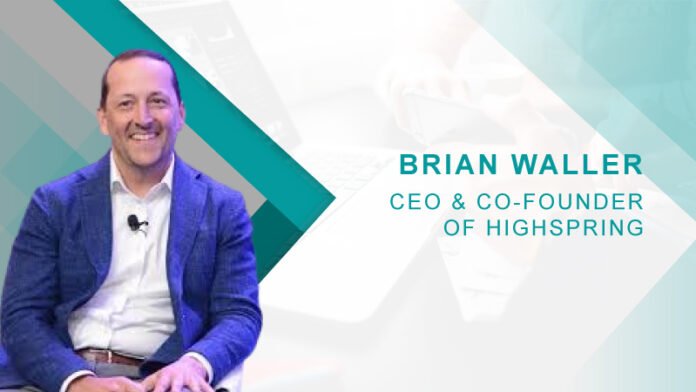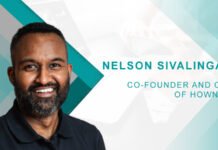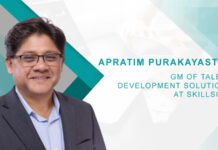To begin, can you please walk us through your professional journey and what led you to launch and lead Highspring?
My journey began over two decades ago when I co-founded Vaco with a group of passionate industry veterans who believed there was a better way to serve clients and professionals in the talent solutions space. We saw an opportunity to build something different: an organization that prioritized people, attracted entrepreneurial thinkers, and delivered customized solutions to unique client challenges. That mindset has endured as we’ve grown into a global professional services firm offering integrated consulting, managed services, and talent solutions.
As we expanded, we brought together an incredible portfolio of specialized solutions and went to market as a family of brands. Over time, it became clear that our GTM plan — though powerful — was complex and difficult for clients to understand. They weren’t just seeking talent or strategy; they needed integrated, tech-enabled solutions to drive business transformation. That realization led to the creation of our new enterprise brand — Highspring. This is more than a brand transformation; it’s a reflection of who we’ve become and where we’re going. Highspring unifies our capabilities under one name, making it easier for clients to understand the full value we offer, while staying true to our culture and entrepreneurial spirit.
You’ve talked about “The Talent Paradox” — why do you believe hiring the right candidate has become harder than ever, despite more tools and platforms being available?
We have more tools, platforms, and data than ever before and the hiring landscape has grown more complex and competitive. Technology has helped widen the talent pool and it’s also overwhelmed companies with volume, making it harder to identify the right fit. At the same time, we’re seeing talent shortages across key functions in the U.S., particularly in areas like IT and finance. This has pushed more companies to explore a global workforce with nearshore and offshore options — something that was once limited to Fortune 1000 firms.
The current uncertainty in the market creates a workforce that’s less likely to make career moves. Candidates today are more selective, and organizations are more cautious. Yet the need for specialized skills and agility has never been higher. Expectations for talent have evolved; it’s not just about technical skills anymore. Companies want strategic thinkers who can navigate change, embrace technology, and add long-term value.
What role do shifting candidate expectations and market conditions play in this paradox?
Shifting candidate expectations and volatile market conditions are at the heart of the talent paradox. Candidates today are looking for more than just a paycheck. They want flexibility, purpose-driven work, growth opportunities, and a culture that aligns with their values. In a market where top talent is in high demand but short supply, these expectations are forcing employers to rethink how they attract and retain people.
As I mentioned, market conditions are adding pressure. Economic uncertainty has made candidates more risk-averse, slowing job movement and reducing churn. On the employer side, companies are being more selective, yet still need to move quickly to secure top talent. It’s a delicate balance, and one that’s increasingly difficult to manage through traditional hiring models alone.
The idea of a borderless workforce is gaining momentum. How do you see global talent strategies giving companies a competitive advantage?
Global talent strategies are no longer a luxury reserved for Fortune 1000 companies. They’re becoming essential for organizations of all sizes looking to stay competitive. As the demand for specialized skills grows and domestic talent pools tighten, companies are increasingly turning to global workforces to access the right capabilities, improve efficiency, and drive innovation.
The advantage lies in both scale and agility. By tapping into nearshore and offshore talent, companies can quickly build and scale teams across time zones, often at lower costs, without sacrificing quality. This isn’t just about outsourcing tasks – it’s about creating strategic, high-performing extensions of your business in new markets. Speed, adaptability, and innovation are key differentiators in today’s environment, and a borderless workforce enables organizations to move fast, fill skill gaps, and remain resilient.
How can companies successfully integrate remote, international talent while maintaining strong company culture and collaboration?
The pandemic reshaped traditional work models by introducing virtual work options to businesses of all sizes, enabling organizations to access new talent pools outside of geographic boundaries. While more organizations begin to shift away from remote work options, corporate leaders are focused on globalizing their workforce to find the best talent across the world.
As more business leaders continue to invest in a borderless workforce, they need to think strategically about how to operate on a global scale. Integrating a distributed workforce into a strong company culture requires careful planning, from tactical decisions like time zone inclusivity to high-level alignment with an organizational mission and core values. By creating a business culture focused on clear goals and values, supplemented by strong leadership and collaboration, executives can create a united workforce.
With the rise of skills-first hiring, how should organizations rethink traditional job requirements — especially the role of a college degree?
Skills-based hiring has become a crucial element of the hiring process, recognizing a range of unique skill sets and individual capabilities. For recruitment leaders, this requires a shift away from traditional expectations that every candidate will have a college degree and towards tangible candidate knowledge. Instead of focusing on degrees and previous job titles, organizations should focus on breaking down jobs by the underlying skills needed for success in those specific roles. By stripping job requirements down to different skill sets, businesses gain a better idea of the capabilities and competencies that drive day-to-day success. By aligning talent with real-time business needs, organizations can become more agile, regardless of traditional credentials.
What are the most important capabilities or soft skills you look for when evaluating talent in a skills-based model?
One of the most important tools for organizations switching to a skill-based hiring model is leveraging different assessment tools to validate skills. While there is no one-size-fits-all approach to determining talent qualifications, businesses can tailor these assessments to roles and industry. Assessments should measure core and transferable competencies like problem-solving, communication and project management, while also providing a unique industry perspective. For businesses regularly working with AI, they can look for talent that demonstrates strong analytics, adaptability and ethical awareness. Skill evaluation will ultimately vary by roles and industry, but by establishing a strong baseline of capabilities, an organization can focus on creating an agile workforce.
How is Highspring helping companies adapt to these changes in the talent landscape?
Agility is at the core of how we help organizations navigate today’s evolving talent landscape. As a global firm, we understand firsthand the importance of building a flexible, responsive workforce that can quickly adapt to shifting business needs. More and more, our clients are embracing global talent strategies — not only to access specialized skills that may be scarce domestically, but also to drive greater efficiency and scalability.
When organizations come to Highspring, they’re looking for a partner that can help them stay nimble. Whether that means outsourcing talent to meet urgent demand, filling critical skill gaps, or managing long-term transformation, we focus on delivering high-quality outcomes without sacrificing speed or precision. From professional staffing solutions for short-term needs to highly specialized consulting support, we give businesses the agility they need to compete — and thrive — in a rapidly changing world.
On a personal level, what’s your strategy for staying ahead in such a fast-changing environment and continuing to lead with purpose?
In today’s evolving marketplace, staying ahead means staying connected. Our growth is directly tied to our ability to help clients navigate significant — and often complex — change. That’s why I prioritize engaging with the executives of the clients we support. The challenges they face are shifting constantly, and staying close to their world helps us stay relevant and responsive.
I also make a point of tuning into the market in a variety of ways — whether that’s listening to earnings calls from public competitors, diving into business publications, or listening to podcasts that explore trends in our space. These insights help sharpen our thinking and better define our differentiators in the market. On a personal level, I’ve always been inspired by entrepreneurial stories — founders who’ve built remarkable companies. There’s a lot to learn from their resilience and innovation, and that spirit of agility is something I try to infuse into our leadership approach.
At the end of the day, our clients’ needs are constantly evolving. If we’re going to lead with purpose, we must be agile — ready to adapt, pivot, and continue earning the trust of those we serve.
Finally, what advice would you share with leaders looking to future-proof their talent approach — and any final thoughts on where hiring is headed next?
The pace of change we’re seeing, especially with the rise of generative AI and digital agents, is redefining the very structure of organizations. We can’t ignore this technology — it’s reshaping how we think about talent, roles, and the capabilities we’ll need moving forward. Companies that thrive in this next era will be the ones that stay ahead of the curve and evolve their workforce strategies accordingly.
One of the most important traits I look for — and would encourage other leaders to prioritize — is curiosity. We need people who are naturally inquisitive, who have a thirst for learning, and who can embrace meaningful organizational change — no matter their functional expertise. Technical skills and domain knowledge will always matter, but the real differentiator in the future of work will be adaptability.
The roles we’ve known for years are changing — some will disappear, many will transform, and new ones will emerge. Those who will rise to the top will be the ones who can lean into uncertainty, are willing to evolve, and who see change not as a threat, but as an opportunity. If leaders can build teams with that mindset, they’ll be well-positioned to navigate whatever comes next.

Brian Waller ,CEO of Highspring
Brian Waller, Chief Executive Officer and Co-Founder of Highspring, drives strategic growth by fostering collaboration and innovation across brands. He co-founded Vaco in 2002 and has roots in Big Four auditing and business development. A University of Tennessee graduate, Brian champions entrepreneurship, mentors startups, and supports philanthropic initiatives.












